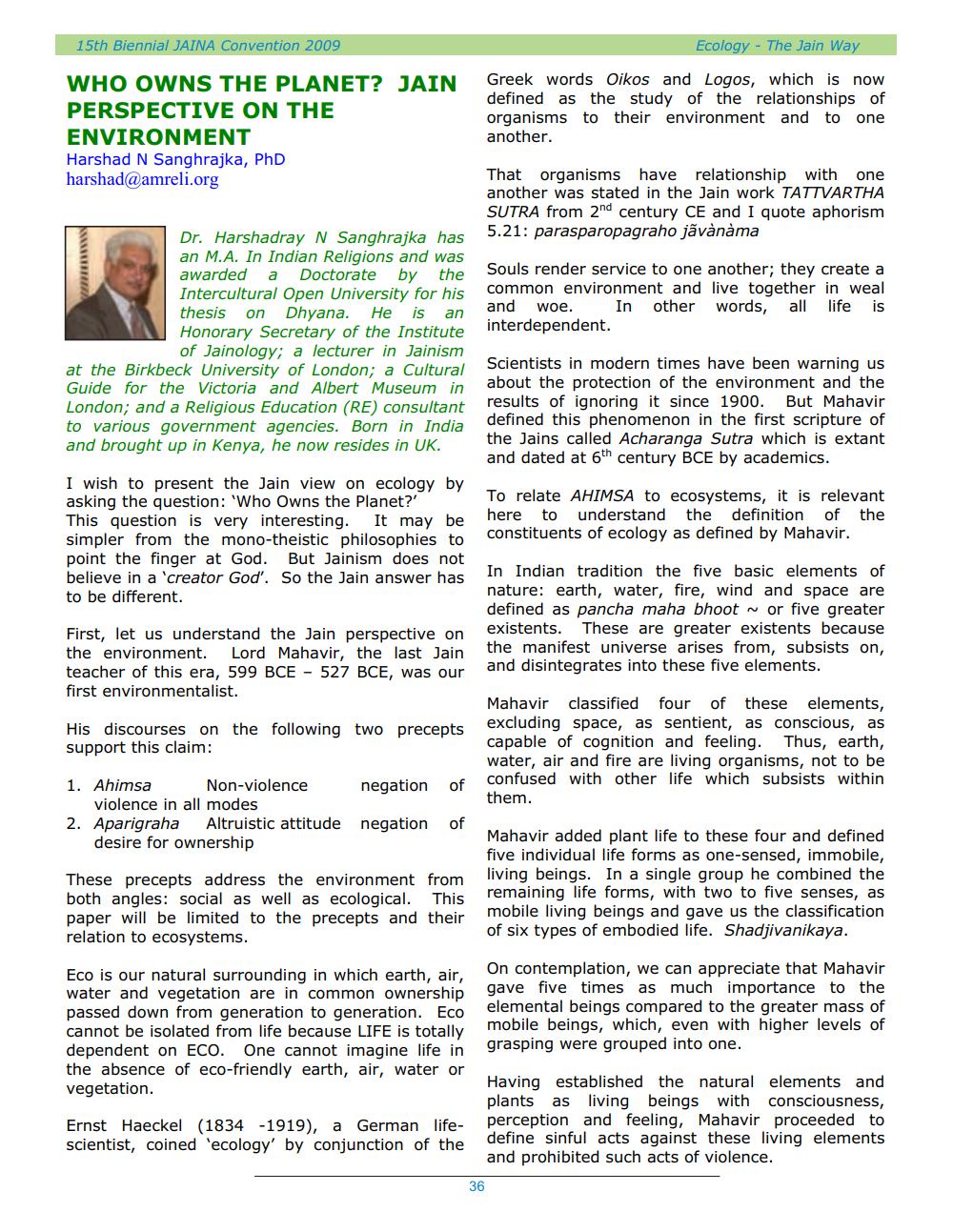________________
15th Biennial JAINA Convention 2009
WHO OWNS THE PLANET? JAIN PERSPECTIVE ON THE
ENVIRONMENT Harshad N Sanghrajka, PhD
[email protected]
Dr. Harshadray N Sanghrajka has
an M.A. In Indian Religions and was awarded a Doctorate by the Intercultural Open University for his thesis on Dhyana. He is an Honorary Secretary of the Institute of Jainology; a lecturer in Jainism at the Birkbeck University of London; a Cultural Guide for the Victoria and Albert Museum in London; and a Religious Education (RE) consultant to various government agencies. Born in India and brought up in Kenya, he now resides in UK.
I wish to present the Jain view on ecology by asking the question: 'Who Owns the Planet?' This question is very interesting. It may be simpler from the mono-theistic philosophies to point the finger at God. But Jainism does not believe in a 'creator God'. So the Jain answer has
to be different.
First, let us understand the Jain perspective on the environment. Lord Mahavir, the last Jain teacher of this era, 599 BCE 527 BCE, was our
first environmentalist.
1. Ahimsa
violence in all modes 2. Aparigraha Altruistic attitude negation of desire for ownership
These precepts address the environment from both angles: social as well as ecological. This paper will be limited to the precepts and their relation to ecosystems.
Eco is our natural surrounding in which earth, air, water and vegetation are in common ownership passed down from generation to generation. Eco cannot be isolated from life because LIFE is totally dependent on ECO. One cannot imagine life in the absence of eco-friendly earth, air, water or vegetation.
Ernst Haeckel (1834 -1919), a German lifescientist, coined 'ecology' by conjunction of the
Ecology - The Jain Way
Greek words Oikos and Logos, which is now defined as the study of the relationships of organisms to their environment and to one another.
That organisms have relationship with one another was stated in the Jain work TATTVARTHA SUTRA from 2nd century CE and I quote aphorism 5.21: parasparopagraho jävànàma
Souls render service to one another; they create a common environment and live together in weal In other words, all life is and woe. interdependent.
Mahavir classified four of these elements,
His discourses on the following two precepts excluding space, as sentient, as conscious, as support this claim:
capable of cognition and feeling. Thus, earth, water, air and fire are living organisms, not to be
Non-violence negation of confused with other life which subsists within
them.
Scientists in modern times have been warning us about the protection of the environment and the results of ignoring it since 1900. But Mahavir defined this phenomenon in the first scripture of the Jains called Acharanga Sutra which is extant and dated at 6th century BCE by academics.
To relate AHIMSA to ecosystems, it is relevant here to understand the definition of the constituents of ecology as defined by Mahavir.
In Indian tradition the five basic elements of nature: earth, water, fire, wind and space are defined as pancha maha bhoot ~ or five greater existents. These are greater existents because the manifest universe arises from, subsists on, and disintegrates into these five elements.
Mahavir added plant life to these four and defined five individual life forms as one-sensed, immobile, living beings. In a single group he combined the remaining life forms, with two to five senses, as mobile living beings and gave us the classification of six types of embodied life. Shadjivanikaya.
On contemplation, we can appreciate that Mahavir gave five times as much importance to the elemental beings compared to the greater mass of mobile beings, which, even with higher levels of grasping were grouped into one.
36
Having established the natural elements and plants as living beings with consciousness, perception and feeling, Mahavir proceeded to define sinful acts against these living elements and prohibited such acts of violence.
